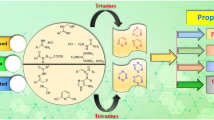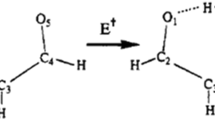Abstract
Structure and bonding characteristics, and gas phase stepwise basicities of proposed multivalent bases 1,3,5,7-tetraazatricyclo[3.3.1.1(3,7)]decane, 1,3,5,7,9,10-hexaazatricyclo[3.3.1.1(3,7)]decane and tricyclo[3.3.1.1(3,7)]azadecane, named and abbreviated here respectively as tetra-aza-adamantane (TAA), hexa-aza-adamantane (HAA) and deca-aza-adamantane (DAA), have been studied using B3LYP/6-311++G** method. Effects of protonation on the bond lengths and angles, and atomic charges, and on their correlations are studied in detail. Results show that the most affected characteristics by protonation are the N–H bond lengths and the charge of the hydrogen atoms. It is found, interestingly, that in the protonation of DAA, electric charges of the unprotonated nitrogen atoms are increased more than that of the protonated nitrogen atoms. Because of very small effects of protonation on the skeletal C–N and N–N bond lengths, it can be said that the aza-adamantane cage volume is not changed significantly upon protonation. The protonation energies approve multivalent nature of these bases with the order of TAA ≈ HAA > DAA. Different isomers for the unprotonated and protonated HAA and DAA are also studied.








Similar content being viewed by others
References
Carey F (2003) Organic chemistry. McGraw Hill, New York
Decker H, Bruce King R (2005) Encyclopedia of inorganic chemistry. Wiley, New York
Elanany M, Su BL, Vercauteren DP (2007) The effect of framework organic moieties on the acidity of zeolites: a DFT study. J Mol Catal A Chem 263(1–2):195–199
Maestre JM, Sarasa JP, Bo C, Poblet JM (1998) Ab initio study of the relative basicity of the external oxygen sites in M2W4O194-(M=Nb and V). Inorg Chem 37(12):3071–3077
Raczynska ED, Darowska M, Cyranski M, Makowski M, Rudka T, Gal JF, Maria PC (2003) Ab initio study of tautomerism and of basicity center preference in histamine, from gas phase to solution-comparison with experimental data (gas phase, solution, solid state). J Phys Org Chem 16(10):783–796
Manoilova OV, Podkolzin SG, Tope B, Lercher J, Stangland EE, Goupil JM, Weckhuysen BM (2004) Surface acidity and basicity of La2O3, LaOCl, and LaCl3 characterized by IR spectroscopy, TPD, and DFT calculations. J Phys Chem B 108(40):15770–15781
Georgieva I, Trendafilova N (2006) Comprehensive DFT and MO studies on glyoxilic acid oxime and related ions in gas phase and solution: conformations, basicities and acidities. Chem Phys 321(3):311–324
Fernández JA, Lopez X, Poblet JM (2007) A DFT study on the effect of metal, anion charge, heteroatom and structure upon the relative basicities of polyoxoanions. J Mol Catal A Chem 262(1–2):236–242
Börner J, Flörke U, Glöge T, Bannenberg T, Tamm M, Jones MD, Döring A, Kuckling D, Herres-Pawlis S (2010) New insights into the lactide polymerisation with neutral N-donor stabilised zinc complexes: comparison of imidazolin-2-imine vs. guanidine complexes. J Mol Catal A Chem 316(1–2):139–145
Hernández-Laguna A, Abboud JLM, Homan H, López-Mardomingo C, Notario R, Cruz-Rodriguez Z, Haro-Ruiz MD, Botella V (1995) N-alpha, N-alpha-dimethylhistamine: a biological superbase in the gas-phase. J Phys Chem 99(22):9087–9094
Kolomeitsev A, Koppel IA, Rodima T, Barten J, Lork E, Röschenthaler GV, Kaljurand I, Kütt A, Koppel I, Mäemets V, Leito I (2005) Guanidinophosphazenes: design, synthesis, and basicity in THF and in the gas phase. J Am Chem Soc 127(50):17656–17666
Kovacevic B, Maksic ZB (2006) High basicity of tris-(tetramethylguanidinyl)-phosphine imide in the gas phase and acetonitrile—a DFT study. Tetrahedron Lett 47(15):2553–2555
Singh A, Ganguly B (2008) Strategic design of small and versatile bicyclic organic superbases: a density functional study. New J Chem 32(2):210–213
Godbey WT, Wu KK, Mikos AG (1999) Poly(ethylenimine) and its role in gene delivery. J Control Release 60(2–3):149–160
Raczyńska ED, Gal JF, Maria PC, Zientara K, Szelag M (2007) Application of FT-ICR-MS for the study of proton-transfer reactions involving biomolecules. Anal Bio Anal Chem 389(5):1365–1380
Raczyńska ED, Gal JF, Maria PC, Szelag M (2009) Proton transfer chemistry in the gas phase. Is a spontaneous’ neutralization’ reaction a myth or a reality? Croat Chem Acta 82(1):87–103
Shim MS, Kwon YJ (2009) Controlled cytoplasmic and nuclear localization of plasmid DNA and siRNA by differentially tailored polyethylenimine. J Control Release 133(3):206–213
Fisher KD, Ulbrich K, Subr V, Ward CM, Mautner V, Blakey D, Seymour LW (2000) A versatile system for receptor-mediated gene delivery permits increased entry of DNA into target cells, enhanced delivery to the nucleus and elevated rates of transgene expression. Gene Ther 7(15):1337–1343
Sonawane ND, Szoka FC, Verkman AS (2003) Chloride accumulation and swelling in endosomes enhances DNA transfer by polyamine-DNA polyplexes. J Biol Chem 278(45):44826–44831
Midoux P, Breuzard G, Gomez JP, Pichon C (2008) Polymer-based gene delivery: a current review on the uptake and intracellular trafficking of polyplexes. Curr Gene Ther 8(5):335–352
Peng L, Liu M, Xue YN, Huang SW, Zhuo RX (2009) Transfection and intracellular trafficking characteristics for poly(amidoamine)s with pendant primary amine in the delivery of plasmid DNA to bone marrow stromal cells. Biomaterials 30(29):5825–5833
Gordadze GN (2008) Geochemistry of cage hydrocarbons. Petrol Chem 48(4):241–253
Qu T (2007) Studies towards the synthesis of nano-diamondoid hydrocarbon cyclohexamantane. Imperial College, London
Uhl W, Cuypers L, Neumüller B, Weller F (2002) Hydrogallation of alkynes: syntheses of carbon–gallium cages possessing heteroadamantane structures. Organometallics 21(12):2365–2368
Schrimpf MR, Sippy K, Anderson D, Bunnelle W, Nersesian D (2008) Amino-aza-adamantane derivatives and methods of use. US Patent No. US20080234308 A2
Kuznetsov AI, Serova TM, Azzheurova IA (2003) Heteroadamantanes and their derivatives: XXV. Synthesis of 3,6-diazahomoadamantane-9-spirothiiranes. Russ J Org Chem 39(6):897–899
Wang JF, Wei DQ, Chou KC (2009) Insights from investigating the interactions of adamantane-based drugs with the M2 proton channel from the H1N1 swine virus. Biochem Biophys Res Commun 388(2):413–417
Bubnov YN, Gursky ME, Pershin DG (1991) A novel method of synthesis of 1-azaadamantane from 1-boraadamantane. J Organomet Chem 412(1–2):1–8
Kuznetsov AI, Zefirov NS (1989) Azaadamantanes with nitrogen atoms in the bridgehead positions. Russ Chem Rev 58(11):1033–1047
Averina NV, Zefirov NS (1976) Advances in the synthesis of heteroadamantanes. Russ Chem Rev 45(6):544–556
Bubnov YN, Kuznetsov NY, Gurskii ME, Semenova AL, Kolomnikova GD, Potapova TV (2006) Construction of nitrogen bicyclic and cage compounds with the use of allylic organoboranes. Pure Appl Chem 78(7):1357–1368
Shi L, Scanio MJC, Bunnelle WH (2008) Aminomethyl azaadamantane derivatives and use thereof as selective modulators of the alpha7-neuronal nicotinic acetylcholine receptor (NNRS). US Patent No. 20080262023
Scanio MJC, Shi L, Bunnelle WH, Schrimpf MR (2008) Acetamide and carboxamide derivatives of azaadamantane and methods of use thereof. US Patent No. 20080255179
Schrimpf MR, Nersesian DL, Sippy KB, Ji J, Li T, Scanio MJC, Shi L, Lee CH, Bunnelle WH, Zhang GGZ, Brackemeyer PJ, Chen S, Henry RF (2008) Azaadamantane derivatives and their uses as nicotinic acetylcholine receptors ligands. US Patent No. 20080167336
Frisch MJ, Trucks GW, Schlegel HB, Scuseria GE, Robb MA, Cheeseman JR, Zakrzewski VG, Montgomery JA Jr, Stratmann RE, Burant JC, Dapprich S, Millam JM, Daniels AD, Kudin KN, Strain MC, Farkas O, Tomasi J, Barone V, Cossi M, Cammi R, Mennucci B, Pomelli C, Adamo C, Clifford S, Ochterski J, Petersson GA, Ayala PY, Cui Q, Morokuma K, Malick DK, Rabuck AD, Raghavachari K, Foresman JB, Cioslowski J, Ortiz JV, Stefanov BB, Liu G, Liashenko A, Piskorz P, Komaromi I, Gomperts R, Martin RL, Fox DJ, Keith T, Al-Laham MA, Peng CY, Nanayakkara A, Gonzalez C, Challacombe M, Gill PMW, Johnson BG, Chen W, Wong MW, Andres JL, Head-Gordon M, Replogle ES, Pople JA (1998) Gaussian 98, a connected system of programs for performing a variety of semi-empirical and ab initio molecular orbital (MO) calculations. Gaussian Inc, Pittsburgh, PA
Kuhn A, Tsotetsi TA, Muller A, Conradie J (2009) Isomer distribution and structure of (2,2′-biphenyldiolato) bis([beta]-diketonato) titanium(IV) complexes: a single crystal X-ray, solution NMR and computational study. Inorg Chim Acta 362(9):3088–3096
Matos MAR, Sousa CCS, Morais VMF (2009) Experimental and computational thermochemistry of the isomers: chromanone, 3-isochromanone, and dihydrocoumarin. J Chem Thermodyn 41(3):308–314
Zoellner JM, Zoellner RW (2009) Uncharged analogues of the phenalenyl cation: Hartree-Fock, Møller-Plesset, and density functional computational investigations of the isomers of boraphenalene. J Mol Struc Theochem 904(1–3):49–56
Lygeros N, Marchand PV, Massot M (2005) Enumeration and 3D representation of the stereo-isomers of alkane molecules. J Symb Comput 40(4–5):1225–1241
Nemba RM, Ngouhouo F (1994) On the enumeration of chiral and achiral skeletons of position isomers of homosubstituted monocyclic cycloalkanes with a ring size n (odd or even). Tetrahedron 50(22):6663–6670
Fujita S (1990) Adamantane isomers with given symmetries. Systematic enumeration by unit subduced cycle indices. Tetrahedron 46(2):365–382
Cyvin SJ, Lloyd EK, Cyvin BN, Brunvoll J (1996) Chemical relevance of a pure combinatorial problem: isomers of conjugated polyenes. Struct Chem 7(3):183–186
Hamidi H, Shams E, Yadollahi B, Esfahani FK (2009) Fabrication of carbon paste electrode containing [PFeW11O39] 4-polyoxoanion supported on modified amorphous silica gel and its electrocatalytic activity for H2O2 reduction. Electrochim Acta 54(12):3495–3500
Ojani R, Ahmadi E, Raoof JB, Mohamadnia F (2009) Characterization of a carbon paste electrode containing organically modified nanostructure silica: application to voltammetric detection of ferricyanide. J Electroanal Chem 626(1–2):23–29
Roberts ME, Mannsfeld SCB, Stoltenberg RM, Bao Z (2009) Flexible, plastic transistor-based chemical sensors. Org Electron 10(3):377–383
Meng F, Sun Z (2009) Enhanced photocatalytic activity of silver nanoparticles modified TiO2 thin films prepared by RF magnetron sputtering. Mater Chem Phys 118(2–3):349–353
Mazeikiene R, Balskus K, Eicher-Lorka O, Niaura G, Meskys R, Malinauskas A (2009) Raman spectroelectrochemical study of electrode processes at neutral red-and poly (neutral red) modified electrodes. Vib Spectrosc 51(2):238–247
Aoki Y, Habazaki H, Kunitake T (2009) Size-scaling of proton conductivity in amorphous aluminosilicate acid thin films. J Am Chem Soc 131(40):14399–14406
Siepe S, Lueckel B, Kramer A, Ries A, Gurny R (2006) Strategies for the design of hydrophilic matrix tablets with controlled microenvironmental pH. Int J Pharm 316(1–2):14–20
Wessels T, McCusker LB, Baerlocher Ch, Reinert P, Patarin J (1998) Synthesis, characterization and structure determination of a new fluorogallophosphate (Mu-5) prepared in the presence of 1,4,8,11-tetraazacyclotetradecane. Microporous Mesoporous Mater 23(1–2):67–77
Acknowledgments
Financial supports of the University of Isfahan as research grant and computing facilities are highly appreciated. We also thank M. J. Jenabi for assistance in graphics.
Author information
Authors and Affiliations
Corresponding author
Electronic supplementary material
Below is the link to the electronic supplementary material.
Rights and permissions
About this article
Cite this article
Sabzyan, H., Saed, B. Computational study of aza-adamantanes as multivalent bases. Struct Chem 23, 1971–1979 (2012). https://doi.org/10.1007/s11224-012-0019-x
Received:
Accepted:
Published:
Issue Date:
DOI: https://doi.org/10.1007/s11224-012-0019-x




